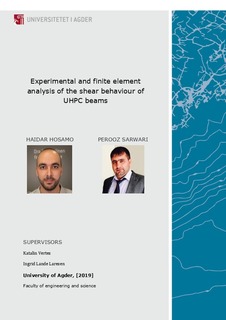| dc.description.abstract | The flexural behavior of reinforced concrete beams isobviously defined and can be managed with reasonableaccuracy.However, a solution has not been obtained for the shear capacity of beams, especially those without shear reinforcement, though numerous models have been established using different approaches. The reason is due to the complexity of shear behavior of reinforced concretebeams,where the load transfer through various componentsof concrete. In addition to this, there is also the effect of reinforcement and cross-section of the memberswhichis linked with dowel action and geometric parameters.All these aspects cause a challenge in quantifying the contribution of each parameter towards shear strength. The uncertainties of these parameters are the reason for not having a principal shear model inthe measurement of the shear capacity of reinforced or un-reinforced concrete beams.This master thesis hasthereforefocused on enhancing the shear resistance of reinforced concrete beams,among a suitable fibre dosage,and the use of UHPC. Experiments, as well as numerical analyses, have been conducted in this thesis. The experiments were divided into 3 parts: cubic and cylinder specimens at different ages to determine the compressive strength,as well as the modulus of elasticity, afour-point bending test on beams to investigate shear strength, and lastly, a three-point bending test on small-scale prismsto determinethe flexural tensile strength.In order to reach a deeper understanding of the shear behavior, finite element (FE) analyses were implemented utilizing the computer software ANSYS. Through ANSYS, several sets of analyses were completed on the simulation offour-point beam bending tests.The large-scale beams were all tested at the mechatronic laboratory at the University of Agder,usingthe four-point bending test. The midspan deflection was measured based on the available machines and a computer was used to register the values.The digital image correlation technique was used to extract the load-deflection curve of several points near to the diagonal shear crack. The experimental results confirm that using the fibrein UHPC beams,will increase the shear strength and the ductility. Replacing stirrups completely with fibres, leads to a reduction of beam depth as well as a decrease in stirrup assembly time.The results were compared with the estimations by Australian guideline, ACI 522, Sharma, Ashour et al., Narayana et al. and Imam et al. The results show that Ashour et al. and Narayana et al. formulas gave the most accurateprediction, while the formula proposed by Sharma wasthe the least accurate.Most of the Finite element modelingresultscorrelated well with ourexperimental results. Hence, using ANSYS may be therightsolution in the future to investigate UHPC beams and to develop design theories of UHPFRC. | nb_NO |

